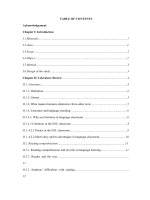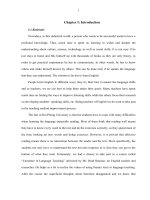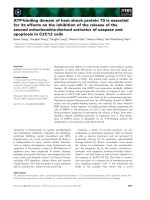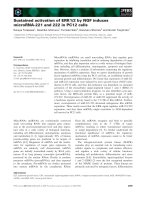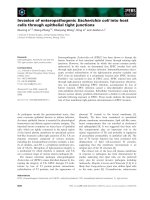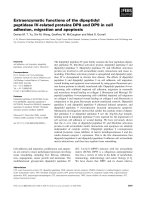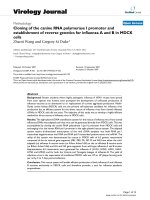Tight junctions and adherens junctions quantifying adhesion and role in mechanotransduction in epithelial cells
Bạn đang xem bản rút gọn của tài liệu. Xem và tải ngay bản đầy đủ của tài liệu tại đây (5.51 MB, 171 trang )
TIGHT JUNCTIONS AND ADHERENS JUNCTIONS:
QUANTIFYING ADHESION AND ROLE IN
MECHANOTRANSDUCTION IN EPITHELIAL
CELLS
Dr. VEDULA SRI RAM KRISHNA
M.B.B.S, University of Pune
M.M.S.T, Indian Institute of Technology
A THESIS SUBMITTED
FOR THE DEGREE OF DOCTOR OF PHILOSOPHY
DIVISION OF BIOENGINEERING
NATIONAL UNIVERSITY OF SINGAPORE
2008
i
Acknowledgements
I would like to express my deepest gratitude to all those who have been instrumental in
making this thesis possible. First and foremost, I would like to thank my supervisor
Associate Professor Lim Chwee Teck for his able guidance, continuous support and
sustained inspiration. If not for him, this thesis would not have been possible. I would
also like to thank Associate Professor Walter Hunziker for his insightful suggestions,
critical comments and for allowing the use of his lab facilities. I would like to thank my
colleagues Mr. Lim Tongseng for helpful discussions and data analysis, Mr. Tan Swee
Jin and Ms. Yan Lian for their help with designing and calibrating the cell stretcher and
Dr. Jaya for help with the cell lines. I would also like to thank all my colleagues Ms. Tan
Eunice, Mr. Hairul Nizam, Dr. Zhou Enhua, Mr. Li Ang, Ms. Shi Hui, Mr. Li Qingsen,
Ms. Yow Sow Zeom, Ms. Sun Wei, Mr. Yuan Jian, Ms. Jiao Guyue, Dr. Earnest, Dr. Fu
Hongxia, Dr. Yousheng and Dr. Yang Zhong at the Nano-biomechanics lab for providing
a lively environment conducive for research. I am indebted to the Nano-bioengineering
lab for allowing me to use their cell culture facilities.
I would also like to thank our collaborators Dr. Terence Dermody & Ms. Kristine
Guglielmi from Vanderbilt Medical Centre, USA and Dr. Thilo Stehle & Ms. Eva
Kirchner from University of Tubingen, Germany for providing protein samples for the
experiments as well as for helpful discussions. I would also like to thank Dr. Yoshimi
Takai from Osaka University for generously providing recombinant nectin-1 fusion
protein. I would also like to thank Prof. Birgit Lane and Prof. Gunaretnam Rajagopal for
their support.
ii
I would like to thank National University of Singapore for providing me with a research
scholarship as well as excellent research and recreational facilities. I would also like to
acknowledge the Biomedical Research Council, Singapore for funding my research work.
I would also like to thank my friends Dr. Karthik, Dr. Dev Kumar, Dr. Sambit and Dr.
Subha Narayan for making my stay in NUS delightful. Last but not the least I am grateful
to my parents, brother and sister for their unconditional love and unwavering support
throughout.
iii
Table of Contents
Acknowledgements i
Table of Contents iii
Summary vii
List of Figures x
List of Symbols xiv
Journal Publications & Book Chapters xv
1 Introduction 1
1.1 Background 1
1.1.1 Intercellular adhesion complex in epithelial monolayers 2
1.1.2 Intercellular adhesion in suspended cells 4
1.1.3 Cell-matrix adhesion 5
1.1.4 Quantifying intercellular adhesion forces 7
1.1.5 Cell adhesion proteins and mechanical stimuli 10
1.2 Objectives and Scope of work 11
2 Literature Review 13
2.1 Structure, organization and functions of Adherens Junctions 13
2.1.1 E-cadherins 13
2.1.2 Nectins 15
2.2 Structure, organization and functions of Tight Junctions 16
2.2.1 Occludin and Claudins 16
2.2.2 Junctional Adhesion Molecules (JAM) 18
2.3 Single Molecule force spectroscopy using AFM 20
2.3.1 Working principle and applications of AFM 20
iv
2.3.2
Methods for functionalizing AFM tips 24
2.3.3 Bell-Evans Model for extracting kinetic parameters in SMFS 29
2.3.4 Data acquisition in SMFS 31
2.3.5 Data analysis in SMFS 35
2.3.6 Determination of the cantilever spring constant 39
2.3.7 SMFS of cell adhesion molecules 40
2.4 Diseases associated with changes in intercellular adhesion molecules 43
2.5 Effect of mechanical strain on intercellular adhesion complex 47
3 Experimental setup, Methods and Materials 51
3.1 Cell culture, proteins and reagents 51
3.2 Single Molecule Force Spectroscopy Set Up 51
3.3 Functionalization of AFM Tips 52
3.4 Single Molecule Force Spectroscopy Experiments on L-fibroblasts 53
3.5 Detection of Rupture Events and Calculating Rupture Force & Loading Rate . 55
3.6 Design, Fabrication and Calibration of Cell Stretcher 59
3.7 Immunofluorescence Staining, Protein Gel Electrophoresis and BrdU Staining66
4 Single molecule force spectroscopy study of homophilic nectin-1 interactions . 68
4.1 Introduction 68
4.1.1 Structure and Organization of Nectins 69
4.1.2 Role of Nectins in Cell Adhesion 72
4.1.3 Single Molecule Force Spectroscopy Study of Homophilic Nectin-1
Interactions 74
4.2 Materials and Methods 75
4.3 Results 75
4.3.1 Force Spectroscopy of L-cell/Nef-1 Interactions 75
v
4.3.2
Kinetic Parameter Extraction for the Different Interaction Configurations of
Nectin-1 Mediated Interactions 81
4.4 Discussion and Conclusion 87
5 Single molecular force spectroscopy study of homophilic JAM-A interactions and
JAM-A interactions with reovirus attachment protein σ1 91
5.1 Introduction 91
5.1.1 Structure and organization of JAMs 92
5.1.2 Role of JAMs in physiological functions and in disease 95
5.1.3 SMFS of homophilic JAM-A interactions and JAM-A interactions with
reovirus attachment protein σ1 100
5.2 Methods and Materials 101
5.3 Results 101
5.3.1 Force spectroscopy of mJAM-A/L-cell interactions 101
5.3.2 Force spectroscopy of σ1/L-cell interactions 106
5.3.3 Energy landscape for dissociation of mJAM-A/mJAM-A and σ1/mJAM-A
complexes 107
5.4 Discussion and Conclusions 108
6 Mechanical Strain Induced Alterations in the Expression and Localization of
Tight Junction Proteins in MDCK Cells 113
6.1 Introduction 113
6.1.1 Mechanosensing, Mechanotransduction and Mechanoresponse 114
6.1.2 Mechanical strain and intercellular adhesion proteins 121
6.2 Methods and Materials 122
6.3 Results 123
6.3.1 Occludin expression is increased in response to mechanical strain 123
6.3.2 Application of mechanical strain is associated with nuclear localization of
ZO-2 but not ZO-1 127
vi
6.3.3
Proliferation is inhibited in cells subjected to cyclical mechanical strain 128
6.4 Discussion and conclusions 131
7 Conclusions and Future Work 135
7.1 Conclusions 135
7.2 Future Work 136
8 Bibliography 138
vii
Summary
Cell adhesion is one of the most important and basic biological phenomenon that is
essential for cells to not only survive and proliferate but also to organize themselves into
complex and better functional units. Cell adhesion allows adherent cell types like
epithelial cells to form monolayers that not only act as barriers to invading pathogens but
also regulate solute and solvent diffusion. The solute transport is not only regulated by
the cells themselves but also by the intercellular adhesion proteins that hold these cells
together. However, these intercellular adhesion proteins are not passive mechanical
barriers to solutes but are highly dynamic, organized complexes that also regulate cellular
processes such as proliferation, differentiation and migration. The expression, distribution
and functions of these cell adhesion proteins are significantly affected by mechanical,
chemical and biological stimuli coming from the surroundings. Apart from their normal
physiological roles, several cell adhesion molecules also act as receptors for a variety of
bacteria, viruses and several other pathogens. Furthermore, different cell adhesion
molecules are bestowed with different structural, adhesive and kinetic properties so that
they can serve different physiological functions. In this dissertation, the adhesion kinetics
of specific intercellular adhesion proteins localizing at adherens junctions and tight
junctions (nectin-1 and JAM-A) were elucidated using single molecule force
spectroscopy. Also the effect of mechanical strain on the expression and localization of
specific tight junction proteins was investigated. Results show that multiple binding
configurations of homophilic nectin-1 interactions exist. Also, the relatively long bond
half life of nectin-1 mediated interactions when compared to initial E-cadherin
interactions provides a strong biophysical support for their role in initiating intercellular
viii
adhesion. On the other hand, homophilic JAM-A interactions were found to be highly
dynamic in nature. Such dynamic interactions provide a biophysical basis for the role of
JAM-A in regulating paracellular diffusion of solutes as well as in trans endothelial
migration of leukocytes. The interactions of the reovirus attachment protein sigma-1 with
JAM-A (which acts as a cell receptor for sigma-1) were found to be kinetically more
stable than homophilic JAM-A interactions and probably help the virus in attaching itself
firmly to the cell. Finally, application of external mechanical strain was found to increase
occludin expression and inhibit proliferation rate in MDCK cells. The increase was also
associated with destabilization and re-localization of the tight junction adaptor protein
ZO-2 from intercellular boundaries into the cytoplasm and nucleus. This strongly
suggests that the tight junction complex plays an important role in regulating and
modulating cellular response to external mechanical strain. The results provide an insight
into the adhesive and mechanotransduction properties of specific intercellular adhesion
molecules.
ix
List of Tables
Table 2.1 Overview of adhesion kinetics of different cell adhesion molecules probed
using SMFS experiments. 41
Table 2.2 List of diseases in various organ systems involving qualitative and/or
quantitative changes in tight junction proteins. 44
Table 2.3 List of diseases associated with altered expression and/or mutations in
adherens junction proteins. 45
Table 2.4 List of diseases arising from altered or impaired function of desmosomal
proteins 46
Table 2.5 List of diseases associated with mutations in different connexins that form gap
junctions. 47
Table 4.1 List of different interactions probed for elucidating nectin-1 interactions. 78
Table 4.2 Unstressed off rates and reactive compliance for different interaction
configurations of nectin-1. 85
Table 5.1 List of different interactions probed for elucidating JAM-A and JAM-A/ σ1
interactions. 104
Table 5.2 JAM-A adhesion kinetic parameters extracted by extrapolating the loading rate
curves. 105
x
List of Figures
Figure 1.1 Schematic showing transcellular and paracellular pathways for solute
diffusion across epithelial monolayers. 2
Figure 1.2 Schematic of the components constituting the intercellular adhesion complex
in epithelial monolayers. 3
Figure 1.3 Schematic of adhesion process involving leukocytes during inflammation. 5
Figure 1.4 Heterodimeric integrins mediate cell-matrix adhesion 6
Figure 2.1 Schematic depiction of the adherens junctions 14
Figure 2.2 Schematic depiction of the tight junctions 17
Figure 2.3 Schematic depiction of the first Atomic Force Microscope constructed based
on the scanning tunneling microscope. 21
Figure 2.4 Schematic depiction of the components and working principle of modern
AFM. 22
Figure 2.5 Schematic depiction of the principle of split photodiode and optical lever
technique used in modern AFM. 23
Figure 2.6 Schematic of AFM tip functionalizing using thiol based methods. 28
Figure 2.7 Schematic of AFM tip functionalization using silanizing agents. 29
Figure 2.8 A typical force displacement curve showing a single bond rupture event 33
Figure 2.9 Schematic depiction of cantilever-linker-receptor-ligand-cell complex 35
Figure 2.10 Relation between bond strength and loading rate on interactions mediated by
transient connectors and persistent connectors. 42
Figure 2.11 Schematic depiction of the various signaling pathways activated in response
to mechanical strain in cells 49
Figure 3.1 Experimental set up for single molecule force spectroscopy experiments. 53
Figure 3.2 Force distance curve obtained on a hard substrate to calculate the deflection
sensitivity of the cantilever. 54
Figure 3.3 Flow chart depicting the sequence of steps in the analysis of F-D curves
acquired in SMFS. 56
xi
Figure 3.4 Smoothing of the F-D curve using a sliding window method. 57
Figure 3.5 Analysis of retract curves with or without bond rupture 58
Figure 3.6 Schematic of the microscope mountable circumferential cell stretcher 60
Figure 3.7 Cell stretching device mounted on a laser confocal microscope enclosed in an
incubation system 61
Figure 3.8 Silicone membrane used for stretching epithelial monolayers showing
markings used for calibration 63
Figure 3.9 Graphs showing calibration of the cell stretcher 65
Figure 4.1 Distribution of nectins in different intercellular junctions 70
Figure 4.2 Structure of nectin and afadin 72
Figure 4.3 Schematic depiction of adhesion mediated by E-cadherins 73
Figure 4.4 Schematic of SMFS set up for probing nectin-1 mediated interactions. 76
Figure 4.5 Typical force-distance curves obtained on L-cells using nef-1 functionalized
cantilevers 77
Figure 4.6 Rupture force histograms of homophilic nectin-1 interactions 78
Figure 4.7 Plot of rupture force magnitude against the logarithm of loading rate for
homophilic nectin-1 interactions 79
Figure 4.8 Schematic depiction of proposed multiple bound states of Nef-1/nectin-1
trans-interactions 80
Figure 4.9 Histogram showing prior distribution of the inverse loading rate. 83
Figure 4.10 Histogram depicting all rupture events recorded at different loading rates for
nef-1/nectin interactions 84
Figure 4.11 Fitting the rupture force vs. logarithm of loading rate data according to
different models 86
Figure 4.12 Schematic depiction of multiple binding configurations in E-cadherin
mediated interactions 88
Figure 4.13 A cartoon showing the role of nectin-1 in the formation of adherens
junction. Interactions between nectin-1 are followed by recruitment of E-cadherins 89
xii
Figure 5.1 Schematic depiction of the basic structure of JAMs 93
Figure 5.2 Crystal structure of JAM-A homodimers 94
Figure 5.3 Models proposed for the organization of JAM-A at the intercellular contact
sites. 96
Figure 5.4 Schematic of the different processes constituting white blood cell
transmigration across endothelial cells during inflammation 97
Figure 5.5 Schematic depiction of the crystal structure of the trimeric reovirus
attachment protein σ1. 99
Figure 5.6 Schematic depiction of the SMFS setup for probing homophilic JAM-A
interactions and JAM-A interactions with reovirus attachment protein σ1. 102
Figure 5.7 Typical force-distance curves obtained on L-cells using JAM-A
functionalized cantilevers 102
Figure 5.8 Histograms of bond rupture frequencies observed for different interaction
types 103
Figure 5.9 Loading rate curves for mJAM-A/mJAM-A and σ1 head/mJAM-A
interactions. 104
Figure 5.10 Energy landscape for the dissociation of σ1/mJAM-A and mJAM-A/mJAM-
A constructed based on the kinetic parameters obtained from SMFS experiments. 109
Figure 6.1 Schematic depiction of how externally applied mechanical forces are
converted into observable cellular responses 115
Figure 6.2 Schematic depiction of the three important MAPK pathways 119
Figure 6.3 Schematic depiction of the PLC pathway. 119
Figure 6.4 Schematic depiction of the NO pathway. 120
Figure 6.5 Confocal microscopy images of MDCK cells stained for occludin. 124
Figure 6.6 Western blot of lysates of MDCK cells stained for occludin and GAPDH. 125
Figure 6.7 Confocal microscopy images of MDCK cells stained for JAM-A 126
Figure 6.8 Immunofluorescence images of MDCK cells stained for ZO-1. 127
Figure 6.9 Immunofluorescence images of MDCK cells stained for ZO-2. 128
xiii
Figure 6.10 Cell proliferation rate assessed using BrdU uptake method. 129
Figure 6.11 MDCK cells double stained for DAPI and BrdU. 130
Figure 6.12 A model for explaining the mechanical strain induced changes in MDCK
cells. 134
xiv
List of Symbols
k
B
Boltzmann constant
k
c
Spring constant of cantilever
k(f) Dissociation rate under an acting force ‘f’
k
off
Unstressed dissociation rate
k
eff
Effective spring constant of the cantilever-molecular linker assembly
p(f) Probability of the rupture of a bond under an acting force ‘f’
r
f
Loading rate
v Retraction velocity of cantilever
x
β
Reactive compliance
t
1/2
Bond half life
xv
Journal Publications & Book Chapters
Lim TS, Vedula SRK, Hunziker W, Lim CT, “Kinetics of adhesion mediated by
extracellular loops of Claudin-2 as revealed by single molecule force spectroscopy”,
Journal of Molecular Biology, Vol. 381, Issue 3, pp. 681-691, 2008.
Lim TS, Vedula SRK, Shi H, Kausalya PJ, Hunziker W, Lim CT, “Probing Effects of pH
change on Dynamic Response of Claudin-2 Mediated Adhesion Using Single Molecule
Force Spectroscopy”, Experimental Cell Research, 2008 Vol. 314, Issue 14, pp. 2643-51.
Vedula SRK, Lim TS, Hunziker W, Lim CT, “Mechanistic insights into physiological
functions of cell adhesion proteins using single molecule force spectroscopy”, Molecular
& Cellular Biomechanics, 2008 Vol. 5, No. 3, pp.169-182.
Vedula SRK, Lim TS, Kirchner E, Guglielmi KM, Dermody TS, Stehle T, Hunziker W
and Lim CT, “A comparative molecular force spectroscopy study of homophilic JAM-A
interactions and JAM-A interactions with Reovirus attachment protein sigma-1”, Journal
of Molecular Recognition, Vol. 21, Issue 4, pp. 210-216, 2008.
Lim TS, Vedula SRK, Jaya Kausalya P, Hunziker W, Lim CT, “Single Molecular Level
study of Claudin-1 mediated adhesion”, Langmuir (2008), Vol. 24, pp. 490-495.
Vedula SRK, Lim TS, Kausalya PJ, Lane B, Rajagopal G, Hunziker W, Lim CT,
“Quantifying forces mediated by integral tight junction proteins in cell-cell adhesion”,
Experimental Mechanics, 2008. (In press)
Vedula SRK, Lim TS, Hui S, Kausalya PJ, Lane EB, Rajagopal G, Hunziker W, Lim CT
“Molecular force spectroscopy of homophilic nectin-1 interactions”, Biochemical and
Biophysical Research Communications (2007), Vol. 362, Issue 4, pp. 886-892.
Vedula SRK, Lim TS, Rajagopal G, Hunziker W, Lane B, Sokabe M, Lim CT “Role of
External Mechanical Forces in Cell Signal Transduction” , Biomechanics at micro- and
nano-scale levels, World Scientific, Singapore, 2007.
Chong KF, Loh KP, Vedula SRK, Lim CT, Sternschulte H, Steinmuller D, Sheu FS,
Zhong YL, “Cell adhesion properties on photochemically functionalized diamond”,
Langmuir (2007), Vol. 23, pp. 5615-5621.
Lim CT, Vedula SRK, Lim TS, Kausalya PJ, Gunaretnam R, Hunziker W. “Molecular
interactions of tight junction proteins in cell-cell interaction”, Journal of Biomechanics,
39, Supplement 1 (2006): S241
xvi
Lim CT, Zhou EH, Li A, Vedula SRK, Fu HX, “Experimental techniques for single cell
and single molecule biomechanics”, Materials Science and Engineering C: Biomimetic
and Supramolecular Systems, Volume 26, Issue 8 , September 2006, Pages 1278-1288
Vedula SRK, Lim TS, Kausalya PJ, Hunziker W, Rajagopal G, Lim CT “Biophysical
approaches for studying the integrity and function of tight junctions”, Molecular &
Cellular Biomechanics (2005), Vol. 2, No. 3, pp. 105-124
Conference Papers
Vedula SRK, Lim TS, Kausalya PJ, Hunziker W, Rajagopal G, Lim CT “Quantifying
inter cellular adhesion forces due to tight junction proteins”, Proceedings of the 12
th
International conference on Biomedical Engineering (ICBME), Singapore, 2005.
Lim C.T, Vedula S.R.K., T.S. Lim., Kausalya P.J., Gunaretnam R., Hunziker W.,
“Quantifying adhesion forces of tight junction proteins in cell-cell adhesion”, Asia and
Pacific workshop on Biological Physics, Singapore, 2006
Lim C.T, Vedula S.R.K., T.S. Lim., Kausalya P.J., Gunaretnam R., Hunziker W.,
“Molecular interactions of tight junction proteins in cell-cell adhesion”, 5
th
World
Congress of Biomechanics, Munich, 2006
Lim TS, Vedula SRK, Kausalya PJ, Hunziker W, Rajagopal G, Lim CT, "Quantifying
adhesion forces of tight junction proteins", poster presentation at the Summer
Bioengineering Conference 2006, Florida.
Vedula SRK, Lim TS, Kausalya PJ, Hunziker W, Rajagopal G, Lim CT, "Quantifying
adhesion forces of tight junction proteins", 2
nd
Tohoku-NUS Joint Symposium on the
Future Nano-medicine and Bioengineering in the East-Asian Region, 2006, Singapore.
Vedula SRK, Lim TS, Kausalya PJ, Hunziker W, Rajagopal G, Lane EB, Lim CT,
“Molecular force spectroscopy of homophilic nectin-1 interactions”, OLS Official
Opening & Conference, Singapore, Feb, 2007.
Vedula SRK, Lim TS, Kausalya PJ, Hunziker W, Rajagopal G, Lane EB, Lim CT,
“Molecular force spectroscopy of homophilic nectin-1 interactions in cell-cell adhesion”,
3
rd
Asian Pacific Conference on Biomechanics (AP Biomech), Tokyo, Nov, 2007.
T.S. Lim, S.R.K. Vedula, S. Hui, J.P. Kausalya, E.B. Lane, G. Rajagopal, W. Hunziker
and C.T. Lim, “Molecular force spectroscopy of homophilic nectin-1 interactions”,
xvii
Biochemical Society Annual Symposium - Structure and function in cell adhesion,
Manchester, UK, Dec,2007.
Lim CT, Vedula SRK, Lim TS, Kausalya PJ, Hunziker W, Rajagopal G, Lane EB,
“Mechanical Insights into the Physiological Functions of Intercellular Adhesion
Molecules”, 3
rd
Tohoku-NUS Joint Symposium on Nano-Biomedical Engineering in the
East Asian-Pacific Rim Region, Singapore, Dec, 2007.
1
1 Introduction
1.1 Background
Cell adhesion is one of the most important and basic biological phenomenon that is
essential for cells to not only survive and proliferate, but also to organize themselves into
more complex and better functional units[1, 2]. Cell adhesion allows adherent cell types
like epithelial cells to form monolayers that line several organ systems e.g. the respiratory
tract, gastrointestinal tract, biliary tract and renal tract just to name a few. Apart from
acting as barriers to invading pathogens, epithelial monolayers are also responsible for
maintaining tissue homeostasis. They are responsible for critically regulating solute and
solvent diffusion across the monolayers to maintain the internal milieu conducive for
tissues to function normally. The solute transport is not only regulated by the cells
themselves but also by the intercellular adhesion proteins that hold these cells together.
However, these intercellular adhesion proteins are not passive mechanical barriers to
solutes but are highly dynamic, organized complexes that also regulate cellular processes
such as proliferation, differentiation and migration[3-5]. The expression, distribution and
functions of these cell adhesion proteins are significantly affected by mechanical,
chemical and biological stimuli coming from the surroundings. For suspended cell types
e.g. leukocytes, adhesion is of primary importance in initiating and promoting the process
of inflammation[6]. Apart from their normal physiological roles, several cell adhesion
molecules also act as receptors for a variety of bacteria, viruses and several other
pathogens[7-9]. Also, several diseases are associated with altered expression,
distribution, structure and/or function of cell adhesion proteins either as a cause or
effect[10]. Furthermore, different cell adhesion molecules are bestowed with different
2
structural, adhesive and kinetic properties so that they can serve different physiological
functions[10]. Correlating the adhesion kinetics of specific intercellular adhesion proteins
to their physiological functions and to study the effect of mechanical stimuli on cell
adhesion proteins is the primary goal of this dissertation.
1.1.1 Intercellular adhesion complex in epithelial monolayers
The organization of a typical epithelial monolayer is shown in Fig. 1.1. There are two
pathways for solutes to diffuse across epithelia. The transcellular pathway is actively
regulated by the cells themselves while the paracellular pathway is guarded by the
intercellular adhesion complex[4, 11]. The intercellular adhesion complex also stabilizes
and maintains the overall architecture of the monolayer.
Figure 1.1 Schematic showing transcellular and paracellular pathways for solute diffusion across
epithelial monolayers.
The intercellular adhesion complex can be classified broadly into four groups (Fig.
1.2)[4]:
3
(a) Tight junction complex: This is located at the top of the intercellular adhesion
complex and forms a circumferential belt around the apical membrane of the cells. The
complex itself is made up of several integral membrane proteins and their corresponding
cytoplasmic adaptors. The tight junction (TJ) complex is considered the major regulator
of the paracellular diffusion of solutes (gate function). The TJ complex also maintains a
differential distribution of proteins (polarity) in the apical and basolateral membranes of
epithelial cells by preventing diffusion of proteins. This function of TJ proteins is often
referred to as the fence function. Apart from this, the cytoplasmic components of the TJ
proteins are also involved in regulating the proliferation and differentiation of cells.
Tight junction
Desmosomes
Adherens junction
Gap junctions
Figure 1.2 Schematic of the components constituting the intercellular adhesion complex
in epithelial monolayers[4].
(b) Adherens junction complex: This complex is located just below the TJ complex.
Similar to the TJ complex, adherens junction (AJ) complex is also constituted by
different membrane proteins and their cytoplasmic adaptors. The primary function of AJ
4
complex unlike the TJ complex is to initiate, develop and maintain the adhesion between
adjacent cells in the epithelial monolayer. The cytoplasmic components associated with
the AJ proteins also play an important role in regulating cell proliferation.
(c) Desmosomes: Desmosomes are proteins that belong to the superfamily of cadherins
and similar to E-cadherins, play an important role in providing mechanical stability to the
intercellular junction. Their importance in maintaining the integrity of intercellular
adhesion is evident in several diseases like pemphigus, where auto antibodies against the
desmosomal protein e.g. desmogelin-1 make the epidermis very fragile leading to the
formation blisters.
(d) Gap junctions: Gap junctions are proteins that provide conduits for neighboring cells
to transmit signals and communicate with one another. Hemi channels of adjacent cells
formed from hexamers of connexins come in contact with one another to form a complete
channel that allows passage of ions and small chemical molecules.
1.1.2 Intercellular adhesion in suspended cells
The importance of intercellular adhesion in suspended cells is exemplified by leukocytes
and monocytes during the process of inflammation. During inflammation, freely flowing
leukocytes and monocytes in the blood are captured by the inflamed endothelial cells
(Fig. 1.3)[6]. Activated endothelial cells express selectins (E-selectin and P-selectin)
which can interact with their corresponding ligands present on the leukocytes (e.g. P-
selectin glycoprotein ligand or PSGL). Furthermore, leukocytes also express molecules
belonging to the integrin family (LFA-1 or leukocyte function associated antigen) which
interact with intercellular adhesion molecule 1 (ICAM-1) thereby promoting adhesion.
5
While some of the adhesion molecules are involved in arresting leukocytes, others are
involved in the crawling and transmigration of the leukocytes across the endothelial cell
junctions (e.g. JAM-A).
Figure 1.3 Schematic of adhesion process involving leukocytes during inflammation[6].
1.1.3 Cell-matrix adhesion
Cell matrix adhesion is mediated by a group of heterodimeric proteins called integrins.
Integrins contain an α chain and a β chain (Fig. 1.4)[12]. They interact with RGD
(Arginine, Glutamic acid and Aspartic acid) sequences present on ECM (extracellular
matrix) proteins like collagen and fibronectin. The engagement of integrins with the
ECM is the starting point for the formation of focal complexes and focal adhesion. The
initial adhesion of integrins to the ECM proteins, called the focal complex, leads to their
clustering and is later strengthened by recruitment of various kinases (e.g. focal adhesion
kinase or FAK and Src), adaptor molecules and the cytoskeleton leading to the formation
of the mature focal adhesion (FA). The FAK and Fyn/Shc pathways represent two main
6
signaling pathways activated by integrins. Apart from these main signaling pathways,
integrins can also initiate several other signaling pathways leading to gene activation and
expression[13-15]. Furthermore, externally applied mechanical forces play an important
role in the maturation of the FA. This “force dependent stiffening” is a very important
characteristic of integrin mediated cell substrate adhesion.
Figure 1.4 Heterodimeric integrins mediate cell-matrix adhesion. They are also important
in initiating several cell signaling pathways[12].
α β
ECM
Integrins
α‐actinin,talin
Ions
Phospholipases
ProteinkinasesLipidkinases
Cytoskeleton
c‐fos,c‐myc,NF‐κBetc.
Geneexpression
Ca
2+
Na
+
,K
+
PI3Kinase FAK,MAPK
PLC,PLA2
7
1.1.4 Quantifying intercellular adhesion forces
Measuring the adhesion forces mediated by various cell adhesion molecules has been a
topic of great interest for biologists as well as biophysicists. To this end, a number of
experimental techniques have been devised for quantifying intercellular adhesion
forces[16]. Initial studies could only be used for studying qualitative differences between
different cell adhesion molecules. This was followed by semi-quantitative methods for
estimating cell adhesion like flow chambers and centrifugation assays. Recent advances
in nano-technological tools have significantly contributed to understanding and
quantifying these adhesion forces in more detail. The advent of techniques based on
micropipettes, optical traps and atomic force microscopy (AFM) has now enabled us to
measure very weak forces, which was previously not possible. This section gives a brief
overview of the different methods for estimating intercellular adhesion forces.
(a) Flow based methods: These methods are based on qualitative or semi quantitative
estimation of the ability of cell adhesion to withstand shear forces. Simple washing[17,
18], shearing through fine bored needles[19], flow chambers and hydrodynamic focusing
using flow cytometer[20] represent some examples of these methods. In the case of
simple washing, one of the cell types labeled with a dye or radioactive substance, are
incubated with a monolayer of the second type of cells. Following washing, the number
of adherent cells is either counted or estimated colorimetrically. In the other methods, the
cells types of interest are incubated for a specified period of time and then passed through
a narrow gauge needle or a flow cytometer at different pressures. In both cases, the
